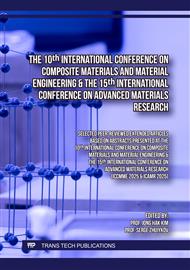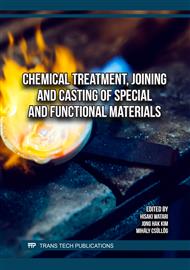[1]
X. Zhang, Y. Zou, J. Fan, and H. Guo, "Usage pattern analysis of Beijing private electric vehicles based on real-world data," Energy, vol. 167, p.1074–1085, Jan. 2019.
DOI: 10.1016/j.energy.2018.11.005
Google Scholar
[2]
Z. Alemayehu, R. B. Nallamothu, M. Liben, S. K. Nallamothu, and A. K. Nallamothu, "Experimental investigation on characteristics of sisal fiber as composite material for light vehicle body applications," Mater. Today Proc., vol. 38, p.2439–2444, 2021.
DOI: 10.1016/j.matpr.2020.07.386
Google Scholar
[3]
E. E. Klu, J. Jiang, G. Wang, B. Gao, A. Ma, and D. Song, "Achieving ultrahigh specific strength of an ultrafine grained Mg–9Li–1Al alloy via the combined processing of ECAP with repeated annealing and rolling," J. Mater. Res. Technol., vol. 25, p.3228–3242, Jul. 2023.
DOI: 10.1016/j.jmrt.2023.06.108
Google Scholar
[4]
L. A. Gonçalves, S. Jiménez, A. Cornejo, M. M. Tedesco, and L. G. Barbu, "A high cycle fatigue numerical framework for component-level virtual fatigue testing: Application to a light-duty vehicle lower control arm," Eng. Struct., vol. 311, p.118198, Jul. 2024.
DOI: 10.1016/j.engstruct.2024.118198
Google Scholar
[5]
M. Y. Khalid, R. Umer, and K. A. Khan, "Review of recent trends and developments in aluminium 7075 alloy and its metal matrix composites (MMCs) for aircraft applications," Results Eng., vol. 20, p.101372, Dec. 2023.
DOI: 10.1016/j.rineng.2023.101372
Google Scholar
[6]
Z. Zhang et al., "Biomimetic porous silicon oxycarbide ceramics with improved specific strength and efficient thermal insulation," J. Mater. Sci. Technol., vol. 168, p.185–193, Jan. 2024.
DOI: 10.1016/j.jmst.2023.06.006
Google Scholar
[7]
E. Georgantzia, M. Gkantou, and G. S. Kamaris, "Aluminium alloys as structural material: A review of research," Eng. Struct., vol. 227, p.111372, Jan. 2021.
DOI: 10.1016/j.engstruct.2020.111372
Google Scholar
[8]
S. Bagherifard, "Enhancing the Structural Performance of Lightweight Metals by Shot Peening," Adv. Eng. Mater., vol. 21, no. 7, p.1801140, Jul. 2019, doi:10.1002/ adem.201801140.
DOI: 10.1002/adem.201801140
Google Scholar
[9]
M. Benedetti, M. Pedranz, V. Fontanari, C. Menapace, and M. Bandini, "Enhancing plain fatigue strength in aluminum alloys through shot peening: Experimental investigations and a strain energy density interpretation," Int. J. Fatigue, vol. 184, p.108299, Jul. 2024.
DOI: 10.1016/j.ijfatigue.2024.108299
Google Scholar
[10]
S. Wu et al., "Unconventional structure evolution stabilizes the ultrahigh specific strength in a nanostructured Al–Mg–Li alloy," Mater. Sci. Eng. A, vol. 860, p.144282, Dec. 2022.
DOI: 10.1016/j.msea.2022.144282
Google Scholar
[11]
M. Taghizadeh and Z. H. Zhu, "A comprehensive review on metal laser additive manufacturing in space: Modeling and perspectives," Acta Astronaut., vol. 222, p.403–421, Sep. 2024.
DOI: 10.1016/j.actaastro.2024.06.027
Google Scholar
[12]
N. Qbau, N. D. Nam, N. T. Hien, and N. X. Ca, "Development of light weight high strength aluminum alloy for selective laser melting," J. Mater. Res. Technol., vol. 9, no. 6, p.14075–14081, Nov. 2020.
DOI: 10.1016/j.jmrt.2020.09.088
Google Scholar
[13]
M. R. Ekici, E. Tabar, G. Hoşgör, E. Bulut, and A. Atasoy, "The effect of zinc, iron and manganese content on gamma shielding properties of magnesium-based alloys produced using the powder metallurgy," Nucl. Eng. Technol., p. S1738573324003553, Jul. 2024.
DOI: 10.1016/j.net.2024.07.039
Google Scholar
[14]
R. Kumar, M. Mursaleen, and G. A. Harmain, "Influence of load ratio on fatigue life assessment of AZ31B magnesium alloy under different temperatures," Theor. Appl. Fract. Mech., vol. 133, p.104557, Oct. 2024.
DOI: 10.1016/j.tafmec.2024.104557
Google Scholar
[15]
J. Hu, X. Nie, S. Fu, Z. Liu, and H. Gao, "Effects of pre-compression modes on mechanical properties and fatigue behaviors of rolled ZK60 magnesium alloy," Int. J. Fatigue, vol. 183, p.108235, Jun. 2024.
DOI: 10.1016/j.ijfatigue.2024.108235
Google Scholar
[16]
L. Xu et al., "High specific strength MWCNTs/Mg-14Li-1Al composite prepared by electrophoretic deposition, friction stir processing and cold rolling," Trans. Nonferrous Met. Soc. China, vol. 32, no. 12, p.3914–3925, Dec. 2022.
DOI: 10.1016/S1003-6326(22)66067-9
Google Scholar
[17]
M. Najafizadeh et al., "Classification and applications of titanium and its alloys: a review," J. Alloys Compd. Commun., p.100019, Aug. 2024.
DOI: 10.1016/j.jacomc.2024.100019
Google Scholar
[18]
Z. Zhang, M. Yang, and G. He, "Effect of TiN monolithic and Ti/TiN multilayer coating on the fatigue behavior of titanium alloy under tension-tension," J. Mater. Res. Technol., vol. 31, p.3675–3689, Jul. 2024.
DOI: 10.1016/j.jmrt.2024.07.105
Google Scholar
[19]
T. Li, H. Wu, D. An, J. Chen, X. Li, and J. Chen, "By introducing heterogeneous interfaces: Improved fatigue crack growth resistance of a metastable β titanium alloy," Scr. Mater., vol. 220, p.114921, Nov. 2022.
DOI: 10.1016/j.scriptamat.2022.114921
Google Scholar
[20]
N. Thiyaneshwaran, C. P. Selvan, A. Lakshmikanthan, K. Sivaprasad, and B. Ravisankar, "Comparison based on specific strength and density of in-situ Ti/Al and Ti/Ni metal intermetallic laminates," J. Mater. Res. Technol., vol. 14, p.1126–1136, Sep. 2021.
DOI: 10.1016/j.jmrt.2021.06.102
Google Scholar
[21]
Z. Zhu, T. Liu, M. Song, Z. Chen, S. Zhang, and C. Dong, "Design of Ti−7Al−2V alloy with high specific strength by using cluster formula," Trans. Nonferrous Met. Soc. China, vol. 33, no. 11, p.3364–3375, Nov. 2023.
DOI: 10.1016/S1003-6326(23)66339-3
Google Scholar
[22]
Z. Zhu, T. Liu, C. Dong, D. Dong, S. Zhang, and Q. Wang, "Achieving high-temperature strength and plasticity in near-α Ti-7Al-3Zr-2V alloy using cluster formula design," J. Mater. Res. Technol., vol. 18, p.2582–2592, May 2022.
DOI: 10.1016/j.jmrt.2022.03.158
Google Scholar
[23]
T. DebRoy et al., "Additive manufacturing of metallic components – Process, structure and properties," Prog. Mater. Sci., vol. 92, p.112–224, Mar. 2018.
DOI: 10.1016/j.pmatsci.2017.10.001
Google Scholar
[24]
F. Zhang, Q. Mao, C. Mei, X. Li, and Z. Hu, "Dome Combustion Hot Blast Stove for Huge Blast Furnace," J. Iron Steel Res. Int., vol. 19, no. 9, p.1–7, Sep. 2012.
DOI: 10.1016/S1006-706X(13)60001-1
Google Scholar
[25]
Y. Zhu, J. Li, X. Tian, H. Wang, and D. Liu, "Microstructure and mechanical properties of hybrid fabricated Ti–6.5Al–3.5Mo–1.5Zr–0.3Si titanium alloy by laser additive manufacturing," Mater. Sci. Eng. A, vol. 607, p.427–434, Jun. 2014.
DOI: 10.1016/j.msea.2014.04.019
Google Scholar
[26]
Y. Zhu, X. Tian, J. Li, and H. Wang, "The anisotropy of laser melting deposition additive manufacturing Ti–6.5Al–3.5Mo–1.5Zr–0.3Si titanium alloy," Mater. Des., vol. 67, p.538–542, Feb. 2015.
DOI: 10.1016/j.matdes.2014.11.001
Google Scholar
[27]
Y. Y. Li, S. Y. Ma, C. M. Liu, and M. Zhang, "Microstructure and Mechanical Properties of Ti-6.5Al-3.5Mo-1.5Zr-0.3Si Alloy Fabricated by Arc Additive Manufacturing with Post Heat Treatment," Key Eng. Mater., vol. 789, p.161–169, Nov. 2018, doi: 10.4028/ www.scientific.net/KEM.789.161.
DOI: 10.4028/www.scientific.net/kem.789.161
Google Scholar
[28]
Q. Zhang, J. Chen, Z. Zhao, H. Tan, X. Lin, and W. Huang, "Microstructure and anisotropic tensile behavior of laser additive manufactured TC21 titanium alloy," Mater. Sci. Eng. A, vol. 673, p.204–212, Sep. 2016.
DOI: 10.1016/j.msea.2016.07.040
Google Scholar
[29]
Y. Zhu, B. Chen, H. Tang, X. Cheng, H. Wang, and J. Li, "Influence of heat treatments on microstructure and mechanical properties of laser additive manufacturing Ti-5Al-2Sn-2Zr-4Mo-4Cr titanium alloy," Trans. Nonferrous Met. Soc. China, vol. 28, no. 1, p.36–46, Jan. 2018.
DOI: 10.1016/S1003-6326(18)64636-9
Google Scholar
[30]
"Carbon fiber mesh," shenghetech.com. Accessed: Jul. 31, 2024. [Online]. Available: https://www.shenghetech.com/products/carbon-fiber-mesh
Google Scholar
[31]
D. Zorko, J. Tavčar, M. Bizjak, R. Šturm, and Z. Bergant, "High cycle fatigue behaviour of autoclave-cured woven carbon fibre-reinforced polymer composite gears," Polym. Test., vol. 102, p.107339, Oct. 2021.
DOI: 10.1016/j.polymertesting.2021.107339
Google Scholar
[32]
"Enhancing specific strength and stiffness of phenolic microsphere syntactic foams through carbon fiber reinforcement - Huang - 2010 - Polymer Composites - Wiley Online Library." Accessed: Aug. 02, 2024. [Online]. Available: https://4spepublications.onlinelibrary. wiley.com/doi/abs/
DOI: 10.1002/pc.20795
Google Scholar
[33]
Z. Lin et al., "Piezoelectric Response and Cycling Fatigue Resistance of Low-Temperature Sintered PZT-Based Ceramics," Materials, vol. 16, no. 4, p.1679, Feb. 2023.
DOI: 10.3390/ma16041679
Google Scholar
[34]
A. Shearer, M. Montazerian, and J. C. Mauro, "Modern definition of bioactive glasses and glass-ceramics," J. Non-Cryst. Solids, vol. 608, p.122228, May 2023.
DOI: 10.1016/j.jnoncrysol.2023.122228
Google Scholar
[35]
Z. Lin et al., "Piezoelectric Response and Cycling Fatigue Resistance of Low-Temperature Sintered PZT-Based Ceramics," Materials, vol. 16, no. 4, Art. no. 4, Feb. 2023.
DOI: 10.3390/ma16041679
Google Scholar
[36]
S. Matsuda, "Theoretical approach to determine dynamic fatigue strength characteristics of ceramics under variable loading rates on the basis of SCG concept," Int. J. Fract., vol. 215, no. 1–2, p.175–182, Jan. 2019.
DOI: 10.1007/s10704-018-00337-7
Google Scholar
[37]
S. Dhanasekar et al., "A Comprehensive Study of Ceramic Matrix Composites for Space Applications," Adv. Mater. Sci. Eng., vol. 2022, p.1–9, Sep. 2022.
DOI: 10.1155/2022/6160591
Google Scholar



